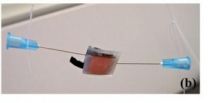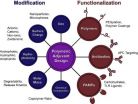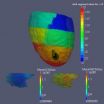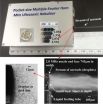(Press-News.org) Using magnetically controlled nanoparticles to force tumour cells to 'self-destruct' sounds like science fiction, but could be a future part of cancer treatment, according to research from Lund University in Sweden.
Watch video:https://www.youtube.com/watch?v=vos0QW2Yclk&feature=youtu.be
"The clever thing about the technique is that we can target selected cells without harming surrounding tissue. There are many ways to kill cells, but this method is contained and remote-controlled", said Professor Erik Renström.
The point of the new technique is that it is much more targeted than trying to kill cancer cells with techniques such as chemotherapy.
"Chemotherapy can also affect healthy cells in the body, and it therefore has serious side-effects. Radiotherapy can also affect healthy tissue around the tumour.
"Our technique, on the other hand, is able to attack only the tumour cells", said Enming Zhang, one of the first authors of the study.
In brief, the technique involves getting the nanoparticles into a tumour cell, where they bind to lysosomes, the units in the cell that perform 'cleaning patrols'. The lysosomes have the ability to break down foreign substances that have entered a cell. They can also break down the entire cell through a process known as 'controlled cell death', a type of destruction where damaged cells dissolve themselves.
The researchers have used nanoparticles of iron oxide that have been treated with a special form of magnetism. Once the particles are inside the cancer cells, the cells are exposed to a magnetic field, and the nanoparticles begin to rotate in a way that causes the lysosomes to start destroying the cells.
The research group at Lund University is not the first to try and treat cancer using supermagnetic nanoparticles. However, previous attempts have focused on using the magnetic field to create heat that kills the cancer cells. The problem with this is that the heat can cause inflammation that risks harming surrounding, healthy tissue. The new method, on the other hand, in which the rotation of the magnetic nanoparticles can be controlled, only affects the tumour cells that the nanoparticles have entered.
The new technique is primarily intended for cancer treatment, but according to Erik Renström and his colleague Enming Zhang there may be other areas of application. One example is autoimmune diseases such as type 1 diabetes, in which the immune system attacks the body's own insulin production.
The 'superparamagnetic nanoparticles' have attracted a lot of interest from academia and industry in recent years. They are being tested in research on new diagnostic laboratory tests, new methods of viewing phenomena in living tissue, and new drugs.
The researchers at Lund University have a patent pending for their technique with the rotating nanoparticles. However, a lot of work remains before it can be transferred from the laboratory to clinical trials on patients.
INFORMATION:
The study is a collaboration between physicists, chemists, engineers and doctors from Sweden, Germany and the USA. It has been published in the American journal ACS Nano.
Nanoparticles cause cancer cells to self-destruct
2014-04-03
ELSE PRESS RELEASES FROM THIS DATE:
Tiny power generator runs on spit
2014-04-03
Saliva-powered micro-sized microbial fuel cells can produce minute amounts of energy sufficient to run on-chip applications, according to an international team of engineers.
Bruce E. Logan, Evan Pugh Professor and Kappe Professor of Environmental Engineering, Penn State, credited the idea to fellow researcher Justine E. Mink. "The idea was Justine's because she was thinking about sensors for such things as glucose monitoring for diabetics and she wondered if a mini microbial fuel cell could be used," Logan said. "There is a lot of organic stuff in saliva."
Microbial ...
Attracting wild bees to farms is a good insurance policy
2014-04-03
EAST LANSING, Mich. -- Investing in habitat that attracts and supports wild bees in farms is not only an effective approach to helping enhance crop pollination, but it can also pay for itself in four years or less, according to Michigan State University research.
The paper, published in the current issue of the Journal of Applied Ecology, gives farmers of pollination-dependent crops tangible results to convert marginal acreage to fields of wildflowers, said Rufus Isaacs, MSU entomologist and co-author of the paper.
"Other studies have demonstrated that creating flowering ...
Pulmonary hypertension deaths have increased over past decade according to CDC report in CHEST
2014-04-03
Deaths from pulmonary hypertension have increased over the past decade, according to a study from the Centers for Disease Control and Prevention (CDC).
In the study, published online in CHEST, researchers analyzed death rates from the National Vital Statistics System and data from the National Hospital Discharge Survey between 2001 and 2010 to analyze trends in hospitalizations and death rates related to pulmonary hypertension.
Pulmonary hypertension is characterized by increased blood pressure in the pulmonary arteries, causing the right side of the heart to work ...
Tiny biomolecular tweezers studying force effect of cells
2014-04-03
A new type of biomolecular tweezers could help researchers study how mechanical forces affect the biochemical activity of cells and proteins. The devices — too small to see without a microscope — use opposing magnetic and electrophoretic forces to precisely stretch the cells and molecules, holding them in position so that the activity of receptors and other biochemical activity can be studied. Arrays of the tweezers could be combined to study multiple molecules and cells simultaneously, providing a high throughput capability for assessing the effects of mechanical forces ...
Enhancing the immune response through next generation polymeric vaccine adjuvants
2014-04-03
The great success of vaccines over the past two centuries as a preventive medicine has led to a significant reduction in morbidity and death caused by controllable infectious diseases. The effectiveness of vaccines is dependent on their ability to induce a protective immune response in recipients. Adjuvants, such as aluminum salts, have been integrated into vaccines for more than 70 years to augment the body's immune response to patho-gens. Adjuvants are especially necessary to boost the immune response for subunit vac-cines. However, conventional adjuvants are limited ...
Diffeomorphometry and geodesic positioning systems for human anatomy
2014-04-03
A team of researchers from the Center for Imaging Science at the Johns Hopkins University and the CMLA of the École Normale Supérieure Cachan have demonstrated new algorithmic technologies for the parametric representation of human shape and form. Coupled with advanced imaging technologies, this presents opportunities for tracking soft-tissue deformations associated with cardiovascular studies, radiation treatment planning in Oncology, and neurodegenerative brain illnesses. The software algorithms provide tools for basic science and pre-clinical investigations for synchronizing ...
Structural insights into the inner workings of a viral nanomachine
2014-04-03
Researchers at the Virginia Tech Carilion Research Institute (VTCRI) are using new nanoscale imaging approaches to shed light on the dynamic activities of rotaviruses, important pathogens that cause life-threatening diarrhea in young children. Once a rotavirus enters a host cell, it sheds its outermost protein layer, leaving behind a double-layered particle (DLP). These DLPs are the form of the virus that produces messenger RNA molecules, which are critical for launching the infection.
Researchers, Deborah Kelly, Ph.D. and Sarah McDonald, Ph.D., both Assistant Professors ...
A pocket-size ultrasonic nebulizer employing a novel nozzle improves inhalers
2014-04-03
Inhalation is an increasingly important route for non-invasive drug delivery for both systemic and local applications. Control of particle size and output plays a critical role in the efficient and effective delivery of oft en expensive medications to the lung. Drugs designed to treat pulmonary diseases or for systemic absorption through the alveolar capillary bed require optimum particle sizes (1 to 6 μm) for effective delivery.
A team of researchers from the Department of Electrical Engineering and Computer Science at the University of California, Irvine has realized ...
An ethics framework should be used to decide health standards for extended, exploratory spaceflights
2014-04-03
WASHINGTON – NASA should use an ethics framework when deciding whether, and under what conditions, spaceflights that venture outside low Earth orbit or extend beyond 30 days are acceptable if they do not meet current health standards, says a new report from the Institute of Medicine, the health arm of the National Academy of Sciences. Exceptions to existing health standards should be granted by NASA on a mission-by-mission basis, and any exceptions should be rare and occur only in extenuating circumstances. The report provides an ethics framework based on six principles ...
Research studies highlight advantages and potential of computer-guided spinal surgery
2014-04-03
LOS ANGELES (April 3, 2014) – In a series of research studies, Cedars-Sinai spinal surgeons show that a new method of computer-guided spine surgery is beneficial for spinal reconstruction and for treating complex tumors and degenerative spine problems, resulting in fewer complications and better outcomes for patients.
The Cedars-Sinai surgeons highlight the advantages of a "spinal navigation" technique that uses high-speed computerized tomography (CT) imaging to navigate in and around the spinal column from different angles. They present their findings in six articles ...






